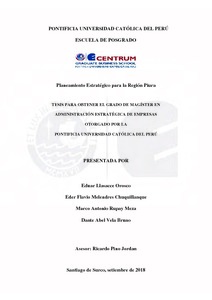| dc.contributor.advisor | Pino Jordan, Ricardo Miguel | |
| dc.contributor.author | Llasacce Orosco, Eduar | es_ES |
| dc.contributor.author | Melendres Chuquillanque, Eder Flavio | es_ES |
| dc.contributor.author | Rupay Meza, Marco Antonio | es_ES |
| dc.contributor.author | Vela Bruno, Dante Abel | es_ES |
| dc.date.accessioned | 2018-09-23T19:44:59Z | |
| dc.date.available | 2018-09-23T19:44:59Z | |
| dc.date.created | 2018 | |
| dc.date.issued | 2018-09-23 | |
| dc.identifier.uri | http://hdl.handle.net/20.500.12404/12709 | |
| dc.description.abstract | La región Piura es una de las pocas regiones del Perú que ha incrementado de manera
notable el valor de sus exportaciones de productos no tradicionales agropecuarios, lo cual ha
permitido un crecimiento en el aspecto económico de la región pero que no necesariamente se
ha traducido en mejoras en el aspecto social. Considerando que la principal preocupación de
los gobiernos regionales es el bienestar de su población, se ha tomado como referencia al
Índice de Progreso Social Regional del Perú (IPSRP) 2017, a fin de evaluar en múltiples
dimensiones varios aspectos que afectan a la calidad de vida de los habitantes.
De acuerdo a la información obtenida por el IPSRP 2017, la región Piura muestra un
ligero incremento en la puntuación general de 58.15 en el 2016 a 58.40 en el 2017,
ubicándose en ambos casos dentro del nivel de progreso social medio bajo, por lo cual tiene
importantes oportunidades de mejora y grandes brechas por cerrar en los componentes de las
tres dimensiones del índice, siendo los más resaltantes: Nutrición y Cuidados Médicos
(medio bajo), Agua y Saneamiento (bajo), Seguridad Personal (medio bajo), Calidad
Ambiental (extremo bajo) y Educación Superior (extremo bajo); todos estos componentes son
los que más afectan en el resultado final del IPSRP 2017 de la región y son la principal fuente
para el análisis y posterior propuesta de los cambios necesarios en beneficio de la población.
Por esta razón, el objetivo fundamental del presente plan estratégico es aprovechar las
capacidades y potencialidades disponibles en la región; se ha identificado factores claves de
éxito en la agroindustria y el turismo, siendo éstos determinantes para el crecimiento de la
región Piura, los cuales fueron analizados y evaluados rigurosamente con la finalidad de
brindar propuestas sólidas y ejecutables por el gobierno regional, enfocado en una visión
holística, global y sostenida, cuyos objetivos de largo plazo están orientados a la agro
exportación del banano, mango, uva y arándano, así como el incremento del turismo
receptivo regional, lo que finalmente generará un impacto positivo en la población. | es_ES |
| dc.description.abstract | The Piura region is one of the few regions of Peru that has significantly increased the
value of its exports of non-traditional agricultural products, which has allowed a growth in
the economic aspect of the region but that has not necessarily translated into improvements in
the social aspect. Considering that the main concern of regional governments is the wellbeing
of their population, the Index of Regional Social Progress of Peru (IPSRP) 2017 has been
taken as a reference, in order to evaluate in several dimensions several aspects that affect the
quality life of the inhabitants.
According to the information obtained by the IPSRP 2017, the Piura region shows a
slight increase in the overall score from 58.15 in 2016 to 58.40 in 2017, placing itself in both
cases within the level of low average social progress, which has important opportunities for
improvement and large gaps to be closed in the components of the three dimensions of the
index, the most outstanding being: Nutrition and Medical Care (medium low), Water and
Sanitation (low), Personal Safety (medium low), Environmental Quality (low end) and
Higher Education (low end); all these components are the ones that most affect the final
result of the IPSRP 2017 in the region and are the main source for the analysis and
subsequent proposal of the necessary changes for the benefit of the population.
For this reason, the fundamental objective of this strategic plan is to take advantage of
the capacities and potential available in the region; key factors of success in agro-industry
and tourism have been identified, being these determinants for the growth of the Piura region,
which were analyzed and evaluated rigorously with the purpose of providing solid and
executable proposals by the regional government, focused on a vision holistic, global and
sustained, whose long-term objectives are aimed at the export of bananas, mango, grapes and
blueberries, as well as the increase of regional receptive tourism, which will ultimately
generate a positive impact on the population. | es_ES |
| dc.language.iso | spa | es_ES |
| dc.publisher | Pontificia Universidad Católica del Perú | es_ES |
| dc.rights | info:eu-repo/semantics/openAccess | es_ES |
| dc.rights.uri | http://creativecommons.org/licenses/by-nc-nd/2.5/pe/ | * |
| dc.subject | Desarrollo regional--Perú--Piura | es_ES |
| dc.subject | Planificación regional--Perú--Piura | es_ES |
| dc.subject | Planificación estratégica | es_ES |
| dc.title | Planeamiento estratégico para la región Piura | es_ES |
| dc.type | info:eu-repo/semantics/masterThesis | es_ES |
| thesis.degree.name | Maestro en Administración Estratégica de Empresas | es_ES |
| thesis.degree.level | Maestría | es_ES |
| thesis.degree.grantor | Pontificia Universidad Católica del Perú. CENTRUM | es_ES |
| thesis.degree.discipline | Administración Estratégica de Empresas | es_ES |
| renati.discipline | 413307 | es_ES |
| renati.level | https://purl.org/pe-repo/renati/level#maestro | es_ES |
| renati.type | https://purl.org/pe-repo/renati/type#tesis | es_ES |
| dc.publisher.country | PE | es_ES |
| dc.subject.ocde | https://purl.org/pe-repo/ocde/ford#5.02.04 | es_ES |






